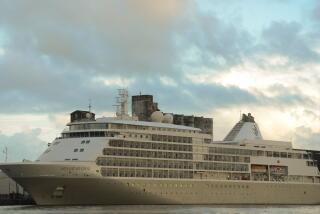Shipboard Medicine Raises Standards
- Share via
More than 7 million passengers are expected to cruise from North American ports this year. Many will be on ships as big as a small town, carrying 2,000 to 3,000 passengers and almost half as many crew. Given those numbers, someone is bound to suffer more than a stomachache or hangover and need professional medical help.
In years past, shipboard medicine has not had a stellar reputation. But that’s changing, cruise industry officials say.
In February, members of the International Council of Cruise Lines, an industry group representing 16 major lines serving U.S. ports, made its recommended guidelines for medical standards (among other areas) a mandatory condition of membership. (The standards are posted on the group’s Web site, https://www.iccl .org, which also lists its members.) The guidelines will be phased in, with compliance expected by the end of this year.
Cruise ships are already subject to standards and regulations established by the International Maritime Organization. Ships calling on U.S. ports also are regulated by federal agencies. The new ICCL standards on health, developed with the American College of Emergency Physicians, meet or exceed the international standards, according to the ICCL.
The ICCL standards on health call for a minimum of one infirmary bed for every 1,000 passengers and crew members and at least one intensive-care bed per ship. The standards also spell out staffing requirements and qualifications for shipboard physicians and nurses.
Medical staff must be skilled in advanced life support and cardiac care, have a current valid medical license (U.S. or international) and be conversant in English. The staff must have general-practice experience plus experience in emergency or critical care, or be board certified or have equivalent experience in emergency medicine, family practice or internal medicine. Three years of clinical experience is recommended.
The required medical equipment includes devices to handle emergencies, including cardiac monitors, defibrillators, portable oxygen and respiratory support equipment. Ships that were delivered after Jan. 1, 1997, must have X-ray facilities.
The trend to obtain consultation services from hospitals and universities, often with the aid of technology, continues. The Holland America line, for instance, has a consultation contract with the University of Texas Medical Branch in Galveston. The line’s ships use the MedServe system, which provides dial-up medical consultations by way of satellite. The system can transmit X-rays, EKGs and live video images to consulting clinicians. Celebrity Cruises has a consultation link with cardiac specialists at the Cleveland Clinic.
Digital cameras are simple but helpful additions on some ships. Sally van Boheemen, manager of fleet medical services for Holland America, says all of the line’s ships have digital cameras. The technology came in handy recently, she said, when a crew member came to the infirmary with an odd rash. The ship’s doctor snapped a digital picture and transmitted it by computer to a dermatology consultant, and soon had a diagnosis and treatment plan.
A common medical “emergency” at sea involves a passenger’s need for medication-often a necessary prescribed drug that has been left at home or lost. Travel experts say it can’t be emphasized often enough: Keep prescription medicine with you, not in locked-away luggage.
Under the ICCL guidelines, supplies of medication should be “reasonable.” Cruise line officials say the pharmacy inventories on board are evaluated regularly to keep up with what doctors are prescribing onshore.
On Carnival Cruise Lines, about 500 medications, both prescription and over-the-counter, are available, says Steve Williams, a registered nurse who is Carnival’s director of medical operations.
Of course, the cost of health care and medications isn’t included in the cruise package (although some lines do hand out free condoms). A visit to the infirmary on a Carnival ship, for example, costs about $50 to $75; an overnight stay costs $125 to $200. A night in the ICU is about $450.
Even with the mandatory guidelines and technological links to land-based facilities, shipboard medicine is inherently limited and can’t duplicate the services found at a community hospital. But the new emphasis on standards does increase the chances of getting the best possible care afloat.
Just as important, maritime medicine experts say, is to understand that some problems are beyond the scope of shipboard care. Acute surgical problems, such as appendicitis, are best handled on land.
One expert estimates that one in 10,000 passengers needs care beyond the scope of the infirmary and must be evacuated to a hospital.
*
The Healthy Traveler appears the second and fourth Sundays of the month. Dohney’s e-mail: kdoheny@compuserve.com.
More to Read
Sign up for The Wild
We’ll help you find the best places to hike, bike and run, as well as the perfect silent spots for meditation and yoga.
You may occasionally receive promotional content from the Los Angeles Times.






